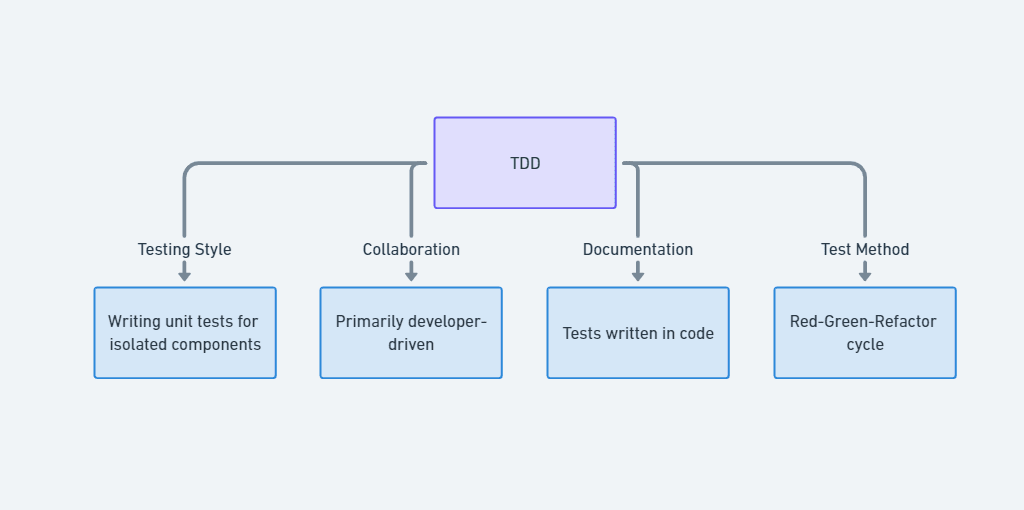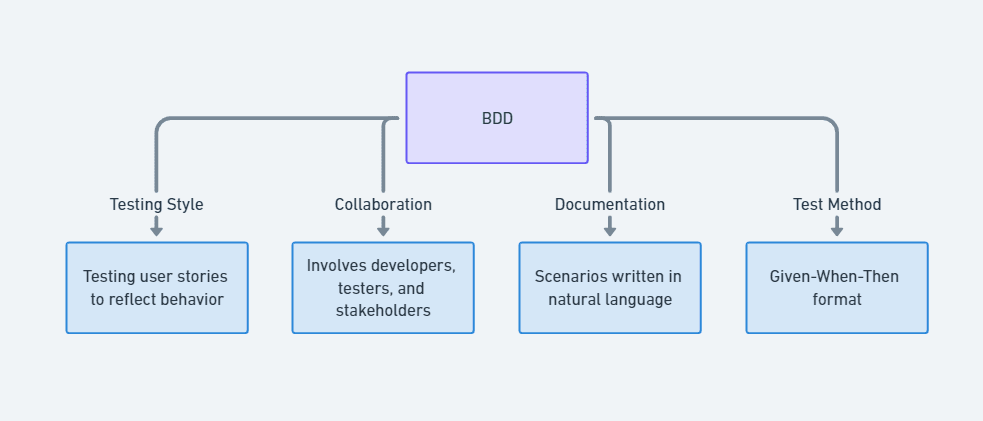Test Driven Development vs Behavior Driven Development
In software development, Test-Driven Development (TDD) and Behavior-Driven Development (BDD) are powerful methodologies that prioritize testing and shape teams' approaches to quality, collaboration, and user satisfaction.

Despite their differences, TDD and BDD share a core focus on improving software quality through rigorous testing, ensuring that the code is reliable and meets its intended purpose.
However, TDD and BDD differ in scope and approach. TDD focuses on validating the correctness of individual code units, ensuring that each function operates as intended.
In contrast, BDD emphasizes the system’s behavior from the user’s perspective, ensuring that the software aligns with user expectations.
Both methodologies prioritize testing and quality, but TDD focuses more on developers, while BDD encourages collaboration and user-centric approaches.
Below is a high-level comparison that showcases these key differences and similarities:
TDD vs. BDD: A Simple Comparison
| TDD | BDD |
| Verifying that the code works as expected at the unit level. | Ensuring the system behaves according to user expectations. |
| Focuses on writing unit tests for small, isolated components. | Emphasizes testing user stories to reflect system behavior. |
| Primarily developer-driven, with minimal stakeholder input. | Involves collaboration among developers, testers, and stakeholders. |
| Test cases are written in the programming language of the code. | Scenarios are written in natural language for shared understanding. |
| Uses the Red-Green-Refactor cycle to guide development. | Follows the Given-When-Then format to define behavior tests. |
This article compares Test-Driven Development (TDD) and Behavior-Driven Development (BDD) and explores their similarities, differences, and applications in real-world scenarios.
Let’s Get a Base Level Understanding
Before diving deeper into the comparison, let’s establish a base-level understanding of TDD and BDD.
What is TDD?
Test-Driven Development (TDD) is a software development methodology where developers write tests before coding.
This methodology follows the Red-Green-Refactor cycle to verify every functionality before implementation.
Overview of Test Driven Development (TDD)
Test Driven Development (TDD) is a methodology that emphasizes writing tests before writing the actual code. This approach ensures that the code meets predefined requirements and functions as expected before development progresses further.
At the heart of TDD is the test-first approach, where tests are written before any code.
The process follows the Red-Green-Refactor cycle: developers first write a failing test (Red), then develop the necessary code to pass the test (Green), and finally, optimize and refactor the code (Refactor) to ensure efficiency and maintainability.
TDD provides several key benefits, including:
- Improves code quality, as every piece of code is rigorously tested.
- Encourages better design by focusing on creating modular, decoupled components.
- Helps developers resolve issues quickly by identifying errors early in the development cycle, resulting in fewer bugs later.
Despite its advantages, TDD presents some challenges:
- The process can be time-consuming, as writing tests up front adds to the initial workload.
- It requires discipline, as developers must consistently follow the cycle.
- Maintaining all tests throughout the development process can be difficult.
What is BDD?
Behavior Driven Development (BDD) extends TDD’s principles but focuses on defining the system’s behavior from a user’s perspective.
BDD uses a more collaborative approach, involving stakeholders in writing test scenarios in natural language.
Overview of Behavior Driven Development (BDD)
Behavior Driven Development (BDD) focuses on defining software behavior based on user stories. It uses the Given-When-Then format to describe interactions, ensuring the system behaves as expected from the user’s perspective.
The core of BDD is collaboration involving developers, testers, and stakeholders. It uses Given-When-Then scenarios, written in natural language, to outline how the software should behave in specific situations.
BDD provides several important benefits, including:
- Enhances communication between technical and non-technical team members, promoting a shared understanding of the goals.
- Makes it easier for all team members, regardless of technical expertise, to understand the requirements.
- Ensures alignment with business objectives by focusing on meeting user expectations and business needs.
Despite its benefits, BDD presents some challenges:
- It can create overhead due to the need for continuous input from stakeholders, which can slow down decision-making.
- The high-level focus on behavior may lead to overlooking edge cases.
- Detailed technical scenarios might not be fully covered in BDD.
A Deeper Level Comparison
Understanding the similarities and differences between TDD and BDD is crucial for selecting the right approach for your development needs.
A deeper comparison highlights how both methodologies ensure quality and reliability and how each can influence the efficiency and effectiveness of the software development process.
Let’s explore these similarities and how they contribute to achieving better software outcomes.
What’s similar?
Although TDD and BDD differ in their approach and focus, they share common goals that ensure software quality and maintainability.
These shared principles highlight the strengths of both methodologies in improving the development process.
- Testing focus: Both aim to ensure code quality and reliability.
- Iterative process: They both follow short, iterative cycles for gradual improvement.
- Feedback loop: Both approaches help developers identify issues early in development.
- Automation: Support for automated testing is central to both TDD and BDD.
- Design improvement: Both encourage better software design through test-first practices.
What’s different?
While TDD and BDD share some common goals, their key differences in approach and focus determine how they are applied in various development scenarios.
Below is a breakdown of their distinct characteristics.
- Correctness vs behavior: TDD focuses on ensuring the correctness of individual code units. BDD, conversely, validates that the system behaves correctly from a user’s perspective.
- Red-Green-Refactor vs Given-When-Then: TDD uses a technical cycle, while BDD employs a user-friendly, scenario-based structure.
- Minimal stakeholder involvement vs collaboration: TDD is primarily developer-focused. BDD, however, emphasizes collaboration between developers, testers, and business stakeholders.
- Programming vs natural language: TDD tests are written in programming languages, while BDD tests are documented in natural language.
- Granularity: TDD focuses on small, granular tests, while BDD concerns higher-level behaviors and interactions.
When to Use TDD / BDD
Both TDD and BDD are powerful methodologies that can significantly improve the quality of your software. However, each is suited to different types of projects depending on the specific goals and requirements.
Understanding when to apply each methodology can ensure your team is aligned with the project’s and stakeholders’ needs.
When to use TDD
- Focus on technical correctness: TDD is ideal for projects where the correctness of each function is critical, such as financial or backend systems.
- Granular testing: It ensures that each function is tested thoroughly before integration, making it suitable for systems requiring rigorous, unit-level testing.
- Early error detection: TDD helps catch potential errors early and maintain system stability, especially when unit testing is essential for verifying individual components.
When to use BDD
- Collaboration between stakeholders: BDD is perfect for projects where collaboration between technical and non-technical stakeholders is important. It uses human-readable language to define requirements.
- User-facing systems: It is highly effective for systems focused on user interactions, ensuring the software behaves according to user expectations.
- Clear documentation: BDD is valuable for projects that require easily understandable documentation to be communicated with stakeholders, especially in agile environments.
Some Real-Life Examples
Understanding how TDD and BDD work in practice can clarify how to apply these methodologies effectively in real-world scenarios.
Let’s examine specific examples to see how these approaches excel in different contexts.
TDD in a financial system
Imagine a financial system that handles complex transactions, interest rate calculations, or loan processing.
In such systems, even a tiny bug or calculation error can have severe financial consequences, leading to inaccurate results, potential legal issues, or a loss of user trust.
TDD is valuable in scenarios like implementing an interest calculation feature, where developers first write unit tests for expected outputs. These tests ensure the calculation logic is correct before the code is written.
Later, if changes are made, the tests serve as a safety net, catching any unintended errors. In essence, TDD ensures precision and correctness at the lowest level of the system.
This approach reduces the risk of bugs reaching production and guarantees that each function performs as expected before it is integrated into the larger system.
BDD in an e-commerce shopping cart system
Consider an e-commerce platform with a shopping cart feature that allows users to browse products, add them to their cart, and proceed to checkout.
The overall user experience is critical for a user-facing system. Users expect the cart to work seamlessly and provide clear feedback on actions, such as adding or removing items, adjusting quantities, and completing transactions.
This is where Behavior-Driven Development (BDD) shines. In a BDD workflow, the behavior of the shopping cart system is defined through collaboration between developers, testers, and business stakeholders.
Scenarios are written in simple, natural language using the Given-When-Then format, easily understood by non-technical team members.
For instance, a scenario might be:
- Given the user is viewing a product,
- When they click the “Add to Cart” button,
- Then, the product should appear in their shopping cart.
By defining user interactions this way, BDD ensures that the system behaves exactly as expected from the user’s perspective.
This methodology focuses on ensuring that individual code components are correct and how they function together as a whole. It emphasizes delivering a seamless and intuitive experience for the end user.
BDD ensures that user stories like adding items to a cart, removing them, or adjusting quantities are implemented correctly and function as intended.
This approach also facilitates clear communication between technical teams and business stakeholders, ensuring everyone is aligned on how the system should behave.
It’s an especially effective method for projects where user experience is a top priority and where misunderstandings about how the system should work could lead to costly revisions.
Conclusion
Both TDD and BDD have their strengths, and the choice depends on the project’s needs. TDD ensures code correctness, while BDD focuses on system behavior and team collaboration.
In many cases, they complement each other, with TDD handling unit tests and BDD managing high-level behavior, resulting in technically sound and user-friendly software.
Why Choose Testlio for Your TDD and BDD Process
- Precision-driven development with TDD: Testlio’s TDD expertise ensures your team writes tests before code, creating reliable, high-quality software with fewer bugs and long-term stability.
- Seamless collaboration with BDD: Testlio’s BDD methodology bridges the gap between developers, QA teams, and stakeholders. Using simple, clear language to define behaviors, we ensure your software meets technical and user-focused requirements.
- Holistic testing for robust results: Testlio combines the strengths of TDD and BDD, providing both low-level unit and high-level behavior-driven tests. This ensures comprehensive testing that covers code integrity and user experience.
- User-centric insights for real-world impact: Testlio’s BDD practices incorporate real-world scenarios, allowing your team to develop software that truly resonates with users and meets their expectations.
- Effortless integration for continuous optimization: Testlio’s approach integrates seamlessly into your development cycle, allowing ongoing testing and refinement of your software. It ensures continuous improvement in both the technical and user-facing aspects.
Take your development to the next level with Testlio! Let our TDD and BDD expertise help you build technically sound software perfectly aligned with user expectations.


